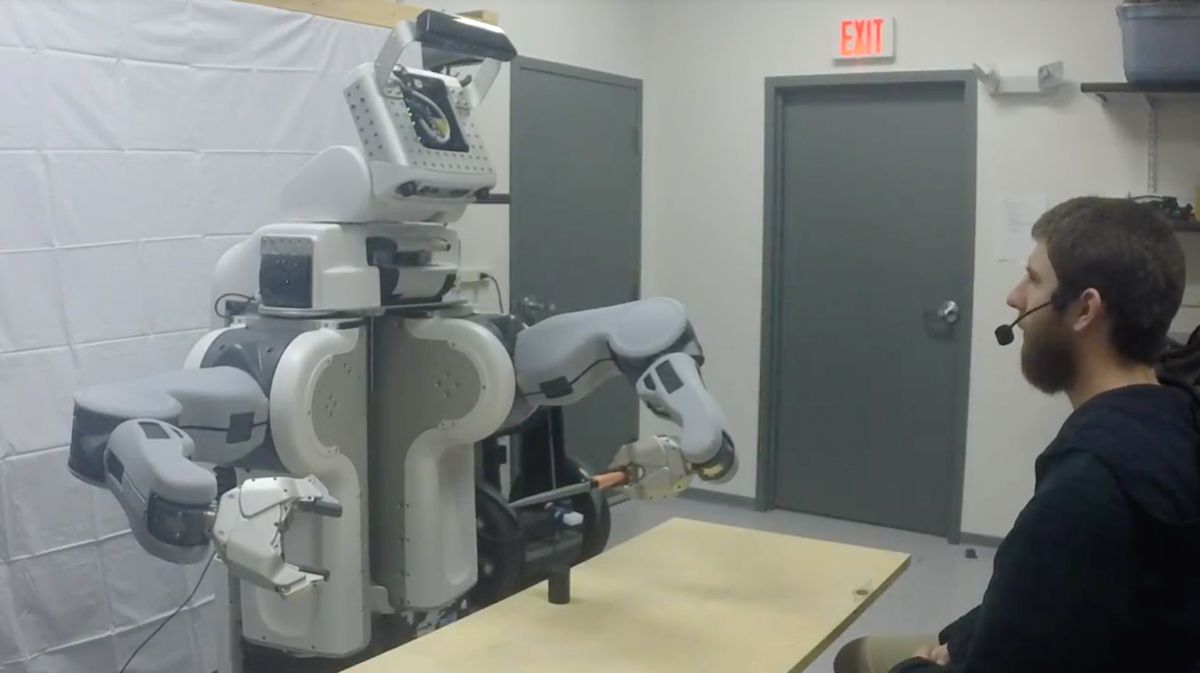Video Friday is your weekly selection of awesome robotics videos, collected by your Automaton bloggers. We’ll also be posting a weekly calendar of upcoming robotics events for the next few months; here’s what we have so far (send us your events!):
ISR 2018 – August 24-27, 2018 – Shenyang, China
BioRob 2018 – August 26-29, 2018 – University of Twente, Netherlands
RO-MAN 2018 – August 27-30, 2018 – Nanjing, China
ELROB 2018 – September 24-28, 2018 – Mons, Belgium
ARSO 2018 – September 27-29, 2018 – Genoa, Italy
ROSCon 2018 – September 29-30, 2018 – Madrid, Spain
IROS 2018 – October 1-5, 2018 – Madrid, Spain
Let us know if you have suggestions for next week, and enjoy today’s videos.
Researchers at the Human Robot Interaction Laboratory at Tufts are teaching their PR2 to pick up objects by giving the robot instructions using natural language. Pretty cool project, but do they have to use a...knife?
[ HRI Lab ]
This robot has mastered the intricacies of the Japanese tea ceremony.
Almost.
[ aNo Lab ]
Hiroshi Ishiguro talks about how to make really intriguing conversations with robots.
[ Yoichi Matsuyama ]
What do you call a video on Duckietown? A Duckumentary!
Duckietown is running a Kickstarter right now, and we’ll have a proper article on it early next week, but if you just can’t wait check it out at the link below.
[ Kickstarter ] via [ Duckietown ]
VOGI is “a novel passively coupled VTOL tiltrotor.” From what I can tell, that means that it is almost literally a quadrotor rubber-banded to some wings and a tail. And some other stuff. But the performance is quite impressive:
If you like the look of this, you can pre-order one for just under USD $1600.
[ VOGI ]
Thanks Jacob!
A friendship with a top-secret robot turns a lonely girl’s life into a thrilling adventure as they take on bullies, evil bots, and a scheming madman. Next Gen, a Netflix Film, launches Sept 7.
I am... Not yet sold on this. It seems, you know, familiar somehow. Also, based on the trailer, the human appears to be little more than a liability. So, realistic, I guess?
[ Netflix ]
Serious question: Can Cozmo recognize itself in a mirror?
[ Cozmo ]
inVia Robotics got a big chunk of funding recently, for those of you who refuse to wait days for sneakers:
[ InVia ]
The Manipulator Teleoperation Package is a hardware and software kit that enables teleoperation of an industrial manipulator, with live camera feeds of the workspace. The kit is currently supported on Clearpath’s Husky UGV and Warthog UGV mobile robotic platforms.
Okay, but why do you need 360 vision and stuff when your mobile robot is big enough to just HULK SMASH its way through pretty much anything?
[ Clearpath ]
Meet Kimberly Hambuchen, Deputy Project Manager Human Robotic Systems at NASA’s Johnson Space Center. Kimberly has been working with robots to make them more usable by humans for more than a decade
[ NASA ]
Just a friendly reminder that Toyota AI Ventures still really wants to give you money.
Humans use letters, which are two-dimensional static symbols. To write these letters, we have to move our body and spend some time; therefore, it can be said that a letter is the trajectory of movement and time. Based on this notion, we studied three types of kinetic typography using robots.
Claudia Pérez D’Arpino’s OPTIMUS robot was excited for the US Gymnastics Championships, which took place in Boston this year:
NOW DO A BACKFLIP.
For reference, here’s Jade Carey’s floor performance, earning her a second place in that event.
First place went to Simone Biles, who’s kiiinda the world champion right now.
[ MIT CSAIL ]
Roboat is a research project and collaboration between the Amsterdam Institute for Advanced Metropolitan Solutions and the Massachusetts Institute of Technology. Roboat is a world-class investigation into the potential of autonomy to change our cities.
[ MIT ]
Droneball? Droneball.
Droneball!
[ Droneball ]
Machine learning and artificial intelligence make extraordinary discoveries possible, and autonomous systems are being rolled out in vital business and social settings including healthcare, policing, and education. Assumptions about the neutrality and objectivity of data may encode serious social and political bias into the results. High-profile examples show how these systems already incorporate into their design human flaws, biases, and assumptions, especially about women and their role in society. In this talk, Professor Gina Neff will show that explicitly thinking about gender in AI will help designers make AI systems that help humans make better—and fairer—decisions.
[ OII ]
Nate Seidle and Pete Dokter talk about the trials, tribulations, and crashes during 10 years of the Autonomous Vehicle Competition.
[ Sparkfun AVC ]
Evan Ackerman is a senior editor at IEEE Spectrum. Since 2007, he has written over 6,000 articles on robotics and technology. He has a degree in Martian geology and is excellent at playing bagpipes.
Erico Guizzo is the Director of Digital Innovation at IEEE Spectrum, and cofounder of the IEEE Robots Guide, an award-winning interactive site about robotics. He oversees the operation, integration, and new feature development for all digital properties and platforms, including the Spectrum website, newsletters, CMS, editorial workflow systems, and analytics and AI tools. An IEEE Member, he is an electrical engineer by training and has a master’s degree in science writing from MIT.



